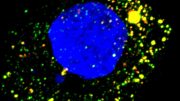
Researchers discovered that the Hepatitis C virus evades the human immune system by cloaking itself with a molecule called FAD, effectively “masking” itself. This discovery could lead to new treatments for viral infections and suggests other viruses might use similar tactics.
Researchers from the University of Copenhagen have unveiled a novel technique to study virus samples, shedding light on the longstanding mystery of how the Hepatitis C virus evades the human immune system. This discovery could influence the way we track and treat viral diseases in general.
Approximately 50 million people around the world are living with chronic hepatitis C infection. This virus is known to induce inflammation and scarring in the liver, which, in severe cases, can progress to liver cancer. Hepatitis C was first identified in 1989, and since then, it has become one of the most extensively researched viruses globally. However, for many years, the mechanism by which this virus evades the human immune system and propagates within the body remained an enigmatic puzzle. Now, for the first time, Danish researchers have unraveled this mystery.
A new method for examining virus samples has led researchers at the University of Copenhagen and Hvidovre Hospital to the answer, which is: the virus just puts on a ‘mask’.
By donning a mask, the virus can remain hidden while making copies of itself to infect new cells. The mask cloaks the virus in the form of a molecule already in our cells. Disguised by the molecule, our immune systems confuse the virus with something harmless that needn’t be reacted to.
“How the Hepatitis C virus manages to hide in our liver cells without being detected by the immune system has always been a bit of a mystery. Our revelation of the virus’ masking strategy is important, as it could pave the way for new ways of treating viral infections. And it is likely that other types of viruses use the same trick,” says Associate Professor Jeppe Vinther of the Department of Biology, who together with associate professor Troels Scheel and professor Jens Bukh from Copenhagen Hepatitis C Program headed the research.
The study has just been published in the scientific journal Nature.
Camouflage for a malicious virus
The mask used by the hepatitis virus to hide in our cells is called FAD, a molecule composed of Vitamin B2 and the energy-carrying molecule ATP. FAD is vital for our cells to convert energy. The FAD molecule’s importance and familiarity with our cells make it ideal camouflage for a malicious virus.
For several years, the research team had a good idea that FAD was helping the virus hide in infected cells, but they lacked a clear way to prove it. To solve the challenge, they turned to Arabidopsis, a well-known experimental plant among researchers.
“We were getting desperate to find a way to prove our hypothesis, which is when we purified an enzyme from the Arabidopsis plant that can split the FAD molecule in two,” explains Anna Sherwood from the Department of Biology, who together with Lizandro Rene Rivera Rangel are first authors of the study.
Using the enzyme, the researchers were able to split the FAD and prove that the hepatitis C virus used it as a mask.
Other viruses probably use the same trick
Like both the coronavirus and influenza virus, Hepatitis C is an RNA virus. Its genetic material consists of RNA that must be copied once the virus enters its host organism. New RNA copies are used to take over new cells, and one end of the RNA’s genetic material is masked by the FAD.
According to Jeppe Vinther, it is very realistic that other RNA viruses use similar masking techniques to spread without being detected by cellular control systems. In fact, researchers have already found another virus that uses the same strategy. And there are likely more.
“All RNA viruses have the same need to hide from the immune system and there is a good chance that this is just the beginning. Now that we’re attuned to this trick, it opens up the possibility of developing new and perhaps improved methods of tracking and treating viral infections in the future,” concludes Jeppe Vinther.
Reference: “Hepatitis C virus RNA is 5′-capped with flavin adenine dinucleotide” by Anna V. Sherwood, Lizandro R. Rivera-Rangel, Line A. Ryberg, Helena S. Larsen, Klara M. Anker, Rui Costa, Cathrine B. Vågbø, Eva Jakljevič, Long V. Pham, Carlota Fernandez-Antunez, Gabriele Indrisiunaite, Agnieszka Podolska-Charlery, Julius E. R. Grothen, Nicklas W. Langvad, Nicolas Fossat, Anna Offersgaard, Amal Al-Chaer, Louise Nielsen, Anna Kuśnierczyk, Christina Sølund, Nina Weis, Judith M. Gottwein, Kenn Holmbeck, Sandro Bottaro, Santseharay Ramirez, Jens Bukh, Troels K. H. Scheel and Jeppe Vinther, 5 July 2023, Nature.
DOI: 10.1038/s41586-023-06301-3
The research is funded by Independent Research Fund Denmark, as well as several other Danish and European foundations and conducted in a collaboration between Jeppe Vinther’s research group at the Department of Biology, University of Copenhagen, and Troels Scheel and Jens Bukh’s research groups from the Copenhagen Hepatitis C Program, which are located at UCPH’s Department of Immunology and Microbiology and the Department of Infectious Diseases at Hvidovre Hospital.









Be the first to comment on "Decades-Old Mystery Solved: How Hepatitis C Evades the Human Immune System"